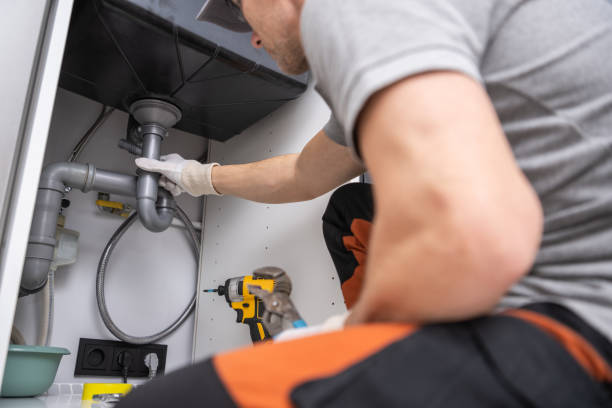How Plumbing Inspection Services Can Detect Leaks Early
Plumbing inspection services help detect leaks early, preventing costly damage. Schedule today for peace of mind and efficient solutions!

Plumbing leaks can be a homeowner’s nightmare. Whether they occur behind walls, under floors, or even in hidden pipes, leaks can cause significant damage over time if left undetected. From costly repairs to the potential for mold growth, a small leak can quickly turn into a big problem. Fortunately, plumbing inspection services are an invaluable tool for detecting leaks early, allowing homeowners to address issues before they escalate. Here’s how these services work and why they’re crucial for maintaining the health of your plumbing system.
What Is a Plumbing Inspection?
A plumbing inspection is a thorough examination of your plumbing system conducted by a licensed and professional plumber. These inspections are typically non-invasive and can identify problems such as leaks, corrosion, blockages, and more. They can be scheduled as routine maintenance, when selling or buying a home, or when you suspect something may be wrong with your plumbing.
During a plumbing inspection, the plumber will examine various aspects of your plumbing system, including pipes, faucets, toilets, water heaters, and sewage lines. They may use specialized tools and equipment to help them detect leaks, including cameras and sensors, making it easier to spot issues that aren’t visible to the naked eye.
How Plumbing Inspection Services Detect Leaks Early
Plumbing inspection services use a variety of advanced methods and tools to detect leaks early, which can prevent major damage and costly repairs. Here are some of the key techniques they use:
1. Visual Inspection of Visible Pipes
The first step in most plumbing inspections involves a visual examination of visible pipes. These may include water pipes under sinks, exposed plumbing in basements, or pipes along exterior walls. The plumber will check for signs of damage, such as cracks, rust, or corrosion, which could indicate a leak. Even if the leak isn’t actively visible, signs like dampness or water stains around pipes can be red flags.
2. Utilizing Leak Detection Technology
For areas where pipes are hidden, modern plumbing inspection services often use specialized technology to detect leaks early. One of the most commonly used tools is a leak detection camera, which is a small, waterproof camera attached to a long cable. The plumber can insert the camera into pipes, drains, and sewer lines, providing a live feed of the interior. This allows them to spot leaks that might not otherwise be visible, even within walls or underground.
Additionally, some plumbers use ultrasonic leak detectors, which emit sound waves to locate leaks within pipes. These devices can identify the sound of water escaping from a pipe, even when the leak is small or difficult to detect. This technology helps plumbers pinpoint leaks precisely without causing damage to the property.
3. Pressure Testing
Pressure testing is another common method for detecting leaks early. During this process, the plumber will temporarily block off the plumbing system and introduce air or water under pressure. If the pressure in the system drops, it indicates that there’s a leak somewhere. This method is particularly useful for detecting leaks in hidden or hard-to-reach pipes that may not be visible to the eye.
Pressure testing can be applied to the water supply system, the sewer lines, and even gas pipes. The accuracy of this method helps to locate leaks quickly, saving both time and money on unnecessary repairs.
4. Infrared Thermography
Infrared thermography uses thermal imaging to detect temperature variations in pipes, walls, and floors. Leaking pipes often cause the surrounding area to become cooler or warmer than the rest of the surfaces, depending on whether water is leaking into the area or evaporating from a wet surface. By using infrared cameras, plumbing professionals can identify these temperature changes, helping them locate hidden leaks with ease.
This method is especially useful for detecting leaks in places like underfloor heating systems, concrete floors, or behind walls, where traditional tools might not be effective.
5. Acoustic Leak Detection
Sometimes, plumbing professionals will use an acoustic leak detection system to listen for the sound of water escaping from pipes. These devices can detect even the smallest sounds of water escaping from a pipe, allowing the plumber to narrow down the location of the leak. Acoustic leak detection is particularly useful in large commercial plumbing systems or in buildings with complex layouts.
6. Dye Testing for Drainage Issues
For sewer lines and drains, plumbers may use dye testing to detect leaks. This involves introducing a non-toxic dye into the plumbing system, and observing if any colored water appears in areas it shouldn’t, such as around a leaking joint or crack. This method is often used in situations where there may be concern about wastewater leaks, which can cause health hazards and significant property damage.
Why Early Leak Detection Matters
Early leak detection is crucial for several reasons, as it can prevent a range of problems that could become costly, disruptive, and damaging if left unchecked. Here’s why it matters:
1. Preventing Water Damage
Even small leaks can cause significant damage over time. If left unchecked, water can seep into walls, floors, and ceilings, leading to costly repairs and potential structural damage. Early detection allows for quick intervention, minimizing the impact on your property.
2. Avoiding Mold and Mildew Growth
Excess moisture from undetected leaks creates the perfect environment for mold and mildew to thrive. Mold can spread quickly and cause health problems, especially for individuals with respiratory issues or allergies. Identifying and repairing leaks early can prevent mold growth, saving you money on cleanup and remediation.
3. Lowering Water Bills
A leak, even a small one, can cause your water bill to skyrocket. By detecting leaks early, homeowners can stop wasting water, keeping their bills manageable. Over time, a hidden leak can add up to a substantial increase in water costs, which could have been avoided with timely detection.
4. Protecting Your Home’s Value
If you’re selling your home, a plumbing inspection can help identify leaks that could otherwise go unnoticed during a standard home inspection. Having a plumbing inspection done before listing your property helps you avoid surprises and ensures your home’s value isn’t compromised by hidden plumbing issues.
5. Reducing Repair Costs
The longer a leak is left unaddressed, the more damage it can cause to your plumbing system. Early detection often means less extensive repairs, keeping your plumbing system in top condition and saving you money in the long run.
Conclusion
Plumbing inspection services play a vital role in detecting leaks early and preventing extensive damage to your home. With advanced technology and expert knowledge, plumbers can pinpoint leaks that may otherwise go unnoticed, saving homeowners time, money, and stress. Whether you’re facing plumbing issues or simply want to prevent future problems, investing in a plumbing inspection is a proactive step toward maintaining the health of your home’s plumbing system. Regular inspections will give you peace of mind, knowing that your pipes are in good condition and free from hidden leaks.







